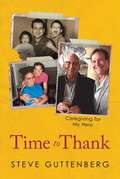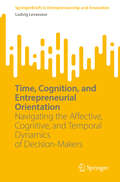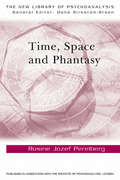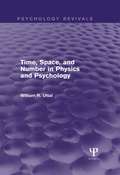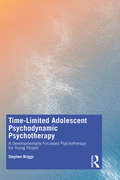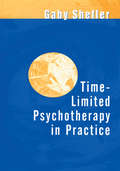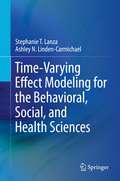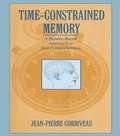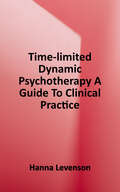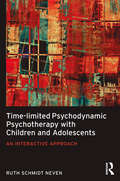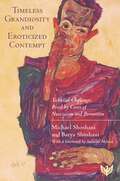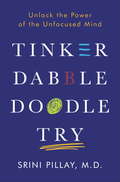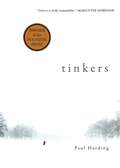- Table View
- List View
Time to Listen to Children: Personal and Professional Communication
by Pat Milner Birgit CarolinTime to Listen to Children is a practical guide to effective communication with children. Professionals working with children in a variety of settings examine the skills required to help children articulate their problems and feelings. They discuss issues such as training, cultural background and religion and give accounts of their work in the following settings: * education * social services * voluntary organizations * medical settings * law Contributors practice a variety of therapeutic techniques, including play, music and art therapy. Time to Listen to Children will be a valuable resource for social workers, teachers and counsellors in training and for all professionals who wish to adopt a skilled, reflective and active approach to their work with children.
Time to Talk: What You Need to Know About Your Child's Speech and Language Development
by Carlyn Kolker Michelle MacRoy-HigginsWhen it comes to language acquisition, all parents have questions…and?this invaluable resource?has all the answers.When should I expect my baby&’s first word? Is my toddler on his way to talking soon? Is my child speaking as clearly as her peers? All parents end up thinking questions like these during their children&’s formative years, but too few act on them, assuming the answers are too unpredictable to be certain. Time to Talk answers these questions for the curious parent.Written by an experienced speech-language pathologist and mom, this practical and proactive guide will help parents:Understand the building blocks of speech and languageMonitor progress against expected milestonesEnhance their child&’s communication skillsSpot signs of potential problems with hearing, speech, or language developmentAddress common concerns, such as articulation, late talking, stuttering, dyslexia, etc.Foster literacyRaise bilingual children successfullyYour child&’s language acquisition no longer must be a guessing game for you. From baby&’s first babbling to reading readiness, Time to Talk provides everything a parent needs so this vital fundamental skill doesn&’t have to be left to chance.
Time to Thank: Caregiving for My Hero
by Steve GuttenbergAfter his father—the hero and strength of the family—is diagnosed with kidney failure, actor Steve Guttenberg dedicates himself to becoming a caregiver and reflects on their life together, from childhood through his Hollywood career, in his father&’s final years.Since moving to Hollywood at age seventeen, Steve Guttenberg has delighted and moved audiences with his film and television work. But when his father is diagnosed with kidney failure, Steve has to step into a new and wholly unexpected role: caretaker. In Time to Thank, Steve tracks his weekly road trips from Los Angeles to Arizona to care for his father and the ways in which his time on the road affords him the perspective to reflect on his life.Through the prism of his relationship with his father, Steve recounts his early life in Queens and Long Island; his early career as a rising Hollywood star, trying to find his way with the encouragement of his parents; and the painful and moving work of helping care for an ailing family member at the end of their life. From glamorous Hollywood parties and film sets around the world to the daily process of dialysis in suburban Phoenix, Steve offers his wit, empathy, and signature charm.This is a book for movie fans, road trip junkies, and anyone who finds themselves doing the hard work of caring for an aging loved one. Steve Guttenberg serves as a uniquely perceptive guide through all these phases of life, with a story that is certain to touch readers and make sure they know that they&’re not alone.
Time, Cognition, and Entrepreneurial Orientation: Navigating the Affective, Cognitive, and Temporal Dynamics of Decision-Makers (SpringerBriefs in Entrepreneurship and Innovation)
by Ludvig LevasseurThis book explores the theoretical connections between time perspective (TP) and strategic and entrepreneurial cognition and entrepreneurial orientation. While time is not a new topic in management and entrepreneurial research, the focus has been on objective/non-psychological time. The primary focus of this book is on the driving impact subjective/psychological time has on entrepreneurs&’ cognition and firms&’ entrepreneurial orientation. The author challenges the dominance of objective time (clock time) in management research, advocating for a focus on subjective time (psychological time) and individual-level analysis. This shift helps to better understand the affective, cognitive, and temporal dynamics of decision-makers, which could lead to more nuanced and coherent models of firm life cycles. This book is a valuable source for researchers, scholars, academics, and students in entrepreneurship and management who are interested in strategic and entrepreneurial cognition, and entrepreneurial orientation.
Time, Progress, Growth and Technology: How Humans and the Earth are Responding (The Frontiers Collection)
by Filipe Duarte SantosThis book addresses the current challenges of sustainable development, including its social, economic and environmental components. The author argues that we need to develop a new concept of time based on inter-generational solidarity, which focuses both on the long- and the short term. The evolution of man's notions of time are analyzed from prehistory to modern times, showing how these concepts shape our worldviews, our ecological paradigms and our equilibrium with our planet. Practical approaches to dealing with the major medium- and long term sustainability challenges of the 21st century are presented and discussed. This is a thought provoking and timely book that addresses the main global socioeconomic and environmental challenges facing the current and future generations, using science-based analysis and perspectives. It presents an historical narrative of the advent of progress, economic growth and technology, and discusses the structural changes needed to co-create sustainable pathways. It provides hope for our future on Earth, mankind’s common home. António Guterres, Secretary-General of the United Nations This is an amazing, almost mind-boggling book. The author takes a look at the true whole, i.e., the development of the human enterprise since its very beginning. This enterprise is evidently a possibility under the boundary conditions of cosmological dynamics and natural evolution, but evidently also a highly improbable one. It is all but a miracle that the Earth system in its present form exists and happens to support a technical civilization. Will this civilization last long, will it transform itself into something even more exceptional, or will it perish in disgrace?Santos dares to address these grandest of all questions, equipped with a unique transdisciplinary wisdom drawing on physics, cybernetics, geology, biology, economics, anthropology, history, and philosophy. And he dares to dive into the deepest abysses of thinking, where categorial monsters like time and progress lurk. Thereby, he takes us on fascinating journey, during which we perceive and grasp things we have never seen and understood before. One of the best essays I have ever read. John Schellnhuber, founding director of the Potsdam Institute for Climate Impact Research (PIK) and former chair of the German Advisory Council on Global Change
Time, Space and Phantasy (The New Library of Psychoanalysis)
by Rosine Jozef PerelbergTime, Space, and Phantasy examines the connections between time, space, phantasy and sexuality in clinical practice. It explores the subtleties of the encounter between patient and analyst, addressing how aspects of the patient’s unconscious past are actualised in the present, producing new meanings that can be re-translated to the past. Perelberg’s analysis of Freud’s Multi-dimensional model of temporality suggests that he always viewed the constitution of the individual as non-linear. In Freud’s formulations, the individual is decentred and ruled by different temporalities, most of which escape their consciousness. Perelberg identifies the similarities between this and Einstein’s theory of relativity which states that rather than being absolute, time depends on the relative position and speed of the observing individual suggesting that rather than being a reality, time is an abstraction, connecting objects and events. Throughout this text, Perelberg draws together connections between time, mental space, and phantasy showing how time is constantly reshaped in the light of new events and experiences. This book will be of interest to psychoanalysts, psychotherapists, psychologists, and social workers.
Time, Space, and Number in Physics and Psychology (Psychology Revivals)
by William R. UttalThe crux of the debate between proponents of behavioral psychology and cognitive psychology focuses on the issue of accessibility. Cognitivists believe that mental mechanisms and processes are accessible, and that their inner workings can be inferred from experimental observations of behavior. Behaviorists, on the contrary, believe that mental processes and mechanisms are inaccessible, and that nothing important about them can be inferred from even the most cleverly designed empirical studies. One argument that is repeatedly raised by cognitivists is that even though mental processes are not directly accessible, this should not be a barrier to unravelling the nature of the inner mental processes and mechanisms. Inference works for other sciences, such as physics, so why not psychology? If physics can work so successfully with their kind of inaccessibility to make enormous theoretical progress, then why not psychology? As with most previous psychological debates, there is no "killer argument" that can provide an unambiguous resolution. In its absence, author William Uttal explores the differing properties of physical and psychological time, space, and mathematics before coming to the conclusion that there are major discrepancies between the properties of the respective subject matters that make the analogy of comparable inaccessibilities a false one. This title was first published in 2008.
Time-Limited Adolescent Psychodynamic Psychotherapy: A Developmentally Focussed Psychotherapy for Young People
by Stephen BriggsTime-Limited Adolescent Psychodynamic Psychotherapy: A Developmentally Focussed Psychotherapy for Young People will be an indispensable clinician’s guide to the practice of Time-Limited Adolescent Psychodynamic Psychotherapy (TAPP), providing comprehensive instruction on the theory and delivery of this distinctive model of psychotherapy. TAPP is a manualised brief psychodynamic psychotherapy of 20 sessions, for young people between, approximately, 14 and 25 years, combining psychodynamic psychotherapy with psychosocial understanding of adolescent difficulties. It places emphasis on the therapeutic engagement of young people and works with a developmental focus to effect change and growth. Divided into two parts, "Conceptual Framework" and "Practice", this book combines digestible scholarly analysis with case studies to effect a one-stop practitioner’s guide to TAPP. Time-Limited Adolescent Psychodynamic Psychotherapy: A Developmentally Focussed Psychotherapy for Young People will be of immense value to clinicians working with young people, researchers engaging with evaluating TAPP and students of psychotherapy.
Time-Limited Art Psychotherapy: Developments in Theory and Practice (Youth, Young Adulthood and Society)
by Rose HughesTime-limited Art Psychotherapy: Developments in Theory and Practice comes at a watershed in the provision of art psychotherapy in public services. The increase in 'payment by results', clinical throughput and evidence-based practice, as well as the changing NHS context means there is an increasing need to provide effective therapeutic treatments within brief time limits where appropriate. The book brings together the developments in theory and practice in time-limited working strategies emerging in the field. The contributors, all practising therapists, examine the practice of time-limited art therapy with different clients in a range of settings, with a variety of approaches, showing how they react and adapt to the changing face of mental health services. Time-limited Art Psychotherapy will be essential reading to trainers and trainees in art psychotherapy and other schools of psychotherapy who integrate creative approaches within their practice. It will also form a useful contribution to the continuing professional development for a range of psychological therapists and practitioners of integrated psychotherapies such as CAT and mentalisation based therapies amongst others.
Time-Limited Counselling (Professional Skills for Counsellors Series #1)
by Colin Feltham`Excellent... [the book] explores the "provision of effective counselling with limited resources and under strict time pressures"... with some excellent writing on the nature of time and attitudes to time in counselling and psychotherapy... the evidence in favour [of short-term counselling] is put strongly. Colin Feltham favours it as an approach of choice for certain clients, which should co-exist with (rather than adversarially seek to oust and replace) longer-term therapy... he draws from a wide range of literature, while identifying those key ingredients, skills and strategies that he has found especially significant. He also discusses some of the different contexts in which this work operates... Many of the questions and issues he poses... will be picked up most productively in training and supervision sessions' - Counselling, The Journal of the British Association for Counselling and Psychotherapy Time-limited counselling - that is, the provision of effective counselling with limited resources and under strict time pressures - is becoming increasingly important as the demand for counselling increases, and the management of waiting lists and costs becomes a crucial concern. In this clearly written book, which incorporates useful, illustrative examples, Colin Feltham outlines the specific practical and technical skills, strategies and knowledge counsellors must have in order to undertake time-limited counselling. Following an examination of the client's induction into counselling, he describes the most appropriate models for different clients and problems. Further chapters assess the management of time-limited counselling in different settings - including private practice - and look at research, training and supervision issues. Squarely addressing the objections to the use of, and real problems in, the practice of this short-term therapeutic paradigm, the author argues that time-limited counselling can be justified not only on economic grounds but also ethically, philosophically, clinically and with reference to consumer preferences. He also identifies the common factors in successful short-term work that span different theoretical orientations.
Time-Limited Existential Therapy: The Wheel of Existence
by Alison StrasserExplore the concept of time as it applies to the therapeutic setting Following the innovative first edition which she co-authored with her late father, Freddie Strasser, in the newly revised Second Edition of Time-Limited Existential Therapy: The Wheel of Existence, distinguished therapist Alison Strasser delivers an insightful aid to integrating and working with existential givens as they arise within a therapeutic encounter. She locates the concept of Time as central to all therapies, regardless of their theoretical modality, and demonstrates how it can be used in brief, short-term, and open-ended therapies. The book relies on the concept of The Wheel to provide a framework for understanding existential and phenomenological philosophies and to help readers put them into practice with clients. It includes meaningful case vignettes that bring existential themes to life and is accessible to both therapists and interested lay members of the public. Finally, the author highlights how our experience with COVID-19 has impacted, and been impacted by, the existential themes we all deal with on a regular basis. A thorough overview of a commonsense existential approach and a discussion of the mystery of time Practical discussions of the limitations and possibilities of time-limited existential therapies, as well as concepts and methods in the area. Comprehensive explorations of the tyranny of high morality, and examinations of the body, the "givents" and "connectedness". Time-Limited Existential Therapy: The Wheel of Existence is an indispensable resource for experienced psychotherapists, counsellors, social workers, coaches, and psychologists, as well as trainees in these fields seeking a common-sense approach to existential ideas in the context of therapy.
Time-Limited Psychotherapy in Practice
by Gaby SheflerTherapists and counsellors are under increasing pressure to provide effective treatment in a time-limited, demonstrably effective form. Time-Limited Psychotherapy (TLP) has developed in response, and is designed to give clients an intense form of therapy over 12 sessions. This title: * Uses vivid clinical descriptions of treatments and up-to-date research findings * Describes what the treatments entail * Discusses their outcome * Deals with teaching and learning of TLP regarding the changing conditions in public needs and in public services. Time-Limited Psychotherapy in Practice will appeal to psychotherapists, counsellors, researchers and academics in the mental health field.
Time-Limited, Intermittent Therapy With Children And Families
by Thomas KreilkampThis book describes an approach to short-term therapy with children and families that has been developed at a health maintenance organization, the Harvard Community Health Plan (HCHP). First published in 1989. Routledge is an imprint of Taylor & Francis, an informa company.
Time-Varying Effect Modeling for the Behavioral, Social, and Health Sciences
by Stephanie T. Lanza Ashley N. Linden-CarmichaelThis book is the first to introduce applied behavioral, social, and health sciences researchers to a new analytic method, the time-varying effect model (TVEM). It details how TVEM may be used to advance research on developmental and dynamic processes by examining how associations between variables change across time. The book describes how TVEM is a direct and intuitive extension of standard linear regression; whereas standard linear regression coefficients are static estimates that do not change with time, TVEM coefficients are allowed to change as continuous functions of real time, including developmental age, historical time, time of day, days since an event, and so forth.The book introduces readers to new research questions that can be addressed by applying TVEM in their research. Readers gain the practical skills necessary for specifying a wide variety of time-varying effect models, including those with continuous, binary, and count outcomes. The book presents technical details of TVEM estimation and three novel empirical studies focused on developmental questions using TVEM to estimate age-varying effects, historical shifts in behavior and attitudes, and real-time changes across days relative to an event. The volume provides a walkthrough of the process for conducting each of these studies, presenting decisions that were made, and offering sufficient detail so that readers may embark on similar studies in their own research. The book concludes with comments about additional uses of TVEM in applied research as well as software considerations and future directions. Throughout the book, proper interpretation of the output provided by TVEM is emphasized.Time-Varying Effect Modeling for the Behavioral, Social, and Health Sciences is an essential resource for researchers, clinicians/practitioners as well as graduate students in developmental psychology, public health, statistics and methodology for the social, behavioral, developmental, and public health sciences.
Time-conscious Psychological Therapy
by Jenifer Elton WilsonCounselors and psychotherapists are divided about the morality and efficacy of short-term psychotherapy and counseling. The model of therapy described Time-Conscious Psychological Therapy is based on flexible adjustment to the life pattern of the individual client's development, showing how a carefully structured, stage-based series of therapeutic relationships can be rewarding for both client and therapist. Illustrated throughout by case examples, this is a book for practitioners of all psychological therapies who are looking for a rigorous but flexible approach to empowering their clients.
Time-constrained Memory: A Reader-based Approach To Text Comprehension
by Jean-Pierre CorriveauThis book tries to answer the question posed by Minsky at the beginning of The Society of Mind: "to explain the mind, we have to show how minds are built from mindless stuff, from parts that are much smaller and simpler than anything we'd considered smart." The author believes that cognition should not be rooted in innate rules and primitives, but rather grounded in human memory. More specifically, he suggests viewing linguistic comprehension as a time-constrained process -- a race for building an interpretation in short term memory. After reviewing existing psychological and computational approaches to text understanding and concluding that they generally rely on self-validating primitives, the author abandons this objectivist and normative approach to meaning and develops a set of requirements for a grounded cognitive architecture. He then goes on to explain how this architecture must avoid all epistemological commitments, be tractable both with respect to space and time, and, most importantly, account for the diachronic and non-deterministic nature of comprehension. In other words, a text may or may not lead to an interpretation for a specific reader, and may be associated with several interpretations over time by one reader. Throughout the remainder of the book, the author demonstrates that rules for all major facets of comprehension -- syntax, reference resolution, quantification, lexical and structural disambiguation, inference and subject matter -- can be expressed in terms of the simple mechanistic computing elements of a massively parallel network modeling memory. These elements, called knowledge units, work in a limited amount of time and have the ability not only to recognize but also to build the structures that make up an interpretation. Designed as a main text for graduate courses, this volume is essential to the fields of cognitive science, artificial intelligence, memory modeling, text understanding, computational linguistics and natural language understanding. Other areas of application are schema-matching, hermeneutics, local connectionism, and text linguistics. With its extensive bibliography, the book is also valuable as supplemental reading for introductory undergraduate courses in cognitive science and computational linguistics.
Time-limited Dynamic Psychotherapy: A Guide To Clinical Practice
by Hanna LevensonTen years ago, Hans Strupp and Jeffrey Binder’s Psychotherapy in a New Key introduced a powerful, empirically tested model of brief psychotherapy that has proven highly successful and changed the practice of psychotherapy forever. But until now, there has been no follow-up publication to make the model come alive. With this book, Hanna Levenson draws on her extensive experience with time-limited dynamic psychotherapy to let readers see the therapy in action.In this era of managed care and limited insurance reimbursement for therapy, many clients are receiving brief therapy treatment. can therapists adjust to these new pressures for efficiency without feeling as if they have to choose between good therapy and brief therapy? Time-limited dynamic psychotherapy provides a state-of-the-art model of treatment that incorporates current developments in psychoanalytic, interpersonal, object-relations, and self-psychology theories, as well as cognitive-behavioral and systems approaches. This flexible approach to brief therapy is designed to treat people with long-standing dysfunctional relationships. This book emphasizes identification of interpersonal difficulties and teaches a method of focusing therapy that is behaviorally based and explicit.In a highly original approach, Levenson presents detailed transcripts not only of model cases but also for students discussing those cases with her, taken from a videotape of her class. A spirited forum on the techniques and aims of time-limited dynamic psychotherapy emerges, adding a depth and richness not usually found in casebooks. This thoughtful, important companion volume to Strupp and Binder’s book will gain a broad following as therapists seek to practice therapy that is effective, efficient, and empirically based.
Time-limited Psychodynamic Psychotherapy with Children and Adolescents: An interactive approach
by Ruth Schmidt NevenAt a time when there is increasing concern about the escalation of child and adolescent mental health problems, Time-limited Psychodynamic Psychotherapy with Children and Adolescents provides an innovative contextual model that engages the child or young person and their parents. The core of the model is the recognition of the dynamic capacity for growth in the child and how this, in itself, creates opportunities for effective treatment over a relatively short period of time. Based on evidence that the most enduring therapeutic outcomes involve a shift in the parents’ relational understanding of themselves, as well as a change in the child, the book uses case examples to show how this model can be applied in everyday therapeutic practice. Time-limited Psychodynamic Psychotherapy with Children and Adolescents is aimed at practitioners in the field of child, adolescent, parent and family psychotherapy. It will interest psychologists, child psychotherapists, doctors, psychiatrists, social workers and mental health workers.
Time-limited Psychodynamic Psychotherapy with Children and Adolescents: An interactive approach
by Ruth Schmidt NevenAt a time when there is increasing concern about the escalation of child and adolescent mental health problems, Time-limited Psychodynamic Psychotherapy with Children and Adolescents provides an innovative contextual model that engages the child or young person and their parents. The core of the model is the recognition of the dynamic capacity for growth in the child and how this, in itself, creates opportunities for effective treatment over a relatively short period of time. Based on evidence that the most enduring therapeutic outcomes involve a shift in the parents’ relational understanding of themselves, as well as a change in the child, the book uses case examples to show how this model can be applied in everyday therapeutic practice. Time-limited Psychodynamic Psychotherapy with Children and Adolescents is aimed at practitioners in the field of child, adolescent, parent and family psychotherapy. It will interest psychologists, child psychotherapists, doctors, psychiatrists, social workers and mental health workers.
Timeless Grandiosity and Eroticised Contempt: Technical Challenges Posed by Cases of Narcissism and Perversion
by Batya Shoshani Michael ShoshaniThe challenges and crises that kept resurfacing in Michael and Batya Shoshani's work with extremely difficult patients hunted by anxieties of being, and in particular with perverse psychic organization, motivated them to write this book. It is an attempt to propose a clinical conceptualisation to enhance their understanding of these lost and confused patients, whose narcissistic struggle against human fate defies reality and truth, challenging the analyst and the analytic situation. Analysts, caught between their own perception of reality and truth and the wish to be empathetic to their patients' experiences and views of reality, often feel torn and as if standing on quicksand. Here, the authors are joining a contemporary movement in the psychoanalytic tradition whilst turning to other disciplines in order to better understand and explain the suffering of their patients. The use of literature, in particular the fictional works of Jorge Luis Borges; film, with an in-depth look at Roman Polanski's Bitter Moon (1992) and Denis Villeneuve's Incendies (2010); and philosophy, the ideas of Heidegger and how they link to those of Freud, coupled together with a solid grasp of psychoanalytic theory, such as reflections on Neville Symington's seminal theory of narcissism, interspersed with real-life case studies bring the chapters alive. Such interplay between the detailed clinical material and conceptual formulations to an interdisciplinary dialogue enables a different outlook that will enrich the ongoing professional discourse on these perplexing and illusive psychic phenomena.
Timeless: Nature's Formula For Health And Longevity
by Louis CozolinoUnlocking the secrets of positive aging. Few prejudices in Western society are more powerful than those concerning aging. Until recently, we have assumed that the story of aging is one of loss and decline. But there’s an entirely different truth. Yes, you can teach an old dog—or even a sort-of-old dog—new tricks. Is there a secret to staying young? It turns out that there are many, and they all begin with nurturing our existing relationships to foster brain health, keeping us happier and healthier. As readers of this book will learn, wisdom, enhanced social relationships, greater adaptation and flexibility (mental, if not physical!)—all these things can be attained as we grow older. Filled with both practical and thought-provoking suggestions, this book is a must-read for anyone who wants to age in style.
Timothy Leary: Early Writings on LSD and Psilocybin with Richard Alpert, Huston Smith, Ralph Metzner, and others
by James PennerThe first collection of Leary’s writings devoted entirely to the research phase of his career, 1960 to 1965 • Presents Leary’s early scientific articles and scholarly essays, including those on the Harvard Psilocybin Project, the Concord Prison Project, and the Good Friday Experiment • With an editor’s introduction that examines the Harvard Drug Scandal in detail as well as a critical preface for each essay On May 27, 1963, Dr. Timothy Leary and Dr. Richard Alpert were dismissed from Harvard University’s Psychology Department--a watershed event marking the moment when psychedelic drugs were publicly demonized and driven underground. Today, little is known about the period in the early 1960s when LSD and psilocybin were not only legal but also actively researched at universities. Presenting the first collection of Leary’s writings devoted entirely to the research phase of his career, 1960 to 1965, this book offers rare articles from Leary’s time as a professor in Harvard’s Psychology Department, including writings from the Harvard Psilocybin Project, the Concord Prison Project, and the Good Friday Experiment. These essays--coauthored with Richard Alpert, Huston Smith, Ralph Metzner, and other psychedelic research visionaries--explore the nature of creativity and the therapeutic, spiritual, and religious aspects of psilocybin and LSD. Featuring Leary’s scientific articles and a rare account of his therapeutic approach, “On Existential Transaction Theory,” the book also includes Leary’s final essay from his time at Harvard, “The Politics of Consciousness,” as well as controversial articles published shortly after his dismissal. With an editor’s introduction examining the Harvard Drug Scandal and a critical preface to each essay, this book of seminal early writings by Leary--appearing in unabridged form--shows why he quickly became an articulate spokesperson for consciousness expansion and an iconic figure for the generation that came of age in the 1960s.
Tinker Dabble Doodle Try: Unlock the Power of the Unfocused Mind
by Srini PillayHarness your mind’s innate tendency to wander, stall, rest, and unfocus and become more productive—in the boardroom, living room, or classroom. To finish tasks and achieve goals, most people believe that more focus is the solution. We rely on to-do lists, calendar reminders, noise-blocking headphones, and sometimes medication to help us concentrate—even though these tactics often fail to substantially improve productivity. Drawing on the latest brain research, compelling stories from his psychological practice, and colorful examples of counterintuitive success from sports, business, education, and the arts, neuroscientist Srini Pillay, M.D., challenges traditional ideas about productivity, revealing the lasting, positive benefits of adding deliberate and regular unfocus to your repertoire. A fascinating tour through brain wavelengths and rhythm, mindsets, and mental relaxation, Tinker Dabble Doodle Try demonstrates how specific kinds of planned unfocus stimulate cognitive calmness, jumpstart productivity, enhance innovation, inspire creativity, improve long-term memory, and, of course, help you stay on target. Tinkering with ideas and with things releases your mind to wander from a state of stuckness into a possibility frame of mind, triggering neural connections and new insights. Dabbling in a new endeavor—whether a hobby or fantasy—disrupts your habitual and reactive thinking, helping you find new solutions to old problems. Doodling can help you tap into another brain frequency to remove obstacles and create opportunities and inspiration. With techniques for training the brain to unfocus, concepts for scheduling busy lives, and ideas for controlling this new cognitive-toggling capability, Tinker Dabble Doodle Try will change how you think about daydreaming, relaxing, leaving work unfinished, and even multitasking. What you’ll discover is a greater freedom, a deeper intelligence, and a more profound joy in your life.Advance praise for Tinker Dabble Doodle Try“Pillay’s effortless writing style, combined with an excellent balance of popular psychology and self-help, makes this a helpful read for those who enjoy a light dive into psychology with practical applications.”—Library Journal“Pillay cites an intriguing range of brain studies to support his argument, and his case studies of individuals with whom he has worked provide useful insights.”—Kirkus Reviews “Dr. Srini Pillay offers a brilliant, deeply researched, and even more deeply imagined blueprint for using one’s full mental armamentarium, conscious, unconscious, and all the undiscovered rest! A fantastic book!”—Edward M. Hallowell, M.D., co-author of Delivered from Distraction “Dr. Pillay’s new book will help you create a new, fun, more playful destiny and unlock your brain’s inner potential.”—Daniel G. Amen, M.D., co-author of The Brain Warrior’s Way “This book not only gives you license to step off the hamster wheel of focus, focus, focus, but it will show you how to strategically and productively do so.”—JJ Virgin, author of JJ Virgin’s Sugar Impact Diet “This brilliant book shows how to manipulate your brain to alternate between intense concentration and deliberate mind-wandering.”—Mark Robert Waldman, co-author of How God Changes Your Brain “Great medicine for those who have long suspected that multitasking and always being on the go aren’t all they are cracked up to be.”—Sara Gottfried M.D., author of The Hormone Cure
Tinkers
by Paul HardingAn old man lies dying. As time collapses into memory, he travels deep into his past where he is reunited with his father and relives the wonder and pain of his impoverished New England youth. At once heartbreaking and life affirming, Tinkers is an elegiac meditation on love, loss, and the fierce beauty of nature. Paul Harding has an MFA from the Iowa Writers’ Workshop and teaches creative writing at Harvard. He lives in Georgetown, Massachusetts.
Tinnitus and Stress
by Agnieszka Szczepek Birgit MazurekThis book provides up-to-date scientific information on the pathways by which psychosocial stress can affect the auditory system and describes current approaches to the management of patients with stress-related tinnitus. The latest evidence is presented on aspects such as the role of stress hormones in auditory function, the effects of allostatic load, circadian sensitivity to auditory trauma, and the association between stress-related biomarkers and tinnitus. The clinically oriented chapters discuss psychometric instruments of value in the tinnitus clinic and present stress-related tinnitus treatment protocols and outcome measures. It is widely acknowledged that the tinnitus percept acts as a stressor. However, it is also now evident that psychosocial stress can play a causative role in tinnitus and that the impact varies according to the level, duration, and quality of the stress. Assessment of the types and levels of stress in tinnitus patients before, during, and after treatment is therefore very important. Healthcare professionals attending tinnitus patients will benefit from the information that this book provides on the relationship between tinnitus and stress and from the practical guidance that it offers.


